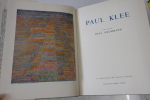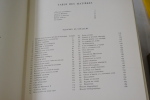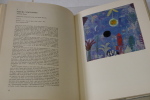Will Grohmann
Paul Klee
Edité par Cercle d'Art, Paris, 1968. Collection la Blibliothèque des Grands Peintres. In-4 relié pleine toile d’éditeur avec jaquette illustrée et étui cartonné. 167pp. Très bon état. Reproductions couleurs hors-texte contre collées, et reproductions en noir et blanc.
Reference : ART1358M
Bookseller's contact details
Librairie du Levant
M. Yannick RENAUD
15 rue Marengo
64100 Bayonne
France
+33 5 59 03 69 40
Payment mode




Sale conditions
We accept payments in € by bank transfers, remote Credit Card, Paypal or checks. Checks made payable to and addressed to: Librairie du Levant 15 rue Marengo 64100 Bayonne France Bank transfers to: Banque Courtois, 1 pl du Réduit 64100 Bayonne / RIB / 10268 02696 62711600200 13 / IBAN / FR76 1026 8026 9662 7116 0020 013 / SWIFT BIC / COURFR2T PAYPAL via the address: librairiedulevant@orange.fr For any remote payment by Credit Card, informations communicated are automatically deleted as soon as payment is made and validated. Shipping upon receipt of payment. Member of the Syndicat des Libraires Anciens et Modernes (SLAM) and of the International League of Antiquarian Booksellers (ILAB), our sales are made according to the customs of the profession. All our books and objetcs are guaranteed to conform to the description which appears in each sheet; if, as a result of an error or an oversight, this was not the case, order will be taken back (within fifteen days) and reimbursed (including the costs of redirection), provided that it is returned in the same condition as the purchase. For obvious technical reasons (format, colors, cropping, viewing angle, etc.), the photographs presented on this site are not contractual. Our prices are in Euros, packaging included. Shipments, made under the responsibility of the buyers, are made by Colissimo Post, registered with insured value from € 50 and up to € 5,000 (delivery against signature, package tracking and insured value); for works less than 50 €, shipments are made by registered letter; works whose value exceeds € 5,000 must be sent by special carrier with insured value and delivery against signature. For any shipment outside mainland France, shipping and insurance costs remain the responsibility of the customer. Shipments are made under the same conditions set out above. Possibility to collect the orders on site. Do not hesitate to keep up to date with our news, finds, curiosities, catalogs and various thematic lists by leaving your contact details by email at librairiedulevant@orange.fr
5 book(s) with the same title
« Éloge de Paul Klee »
Beau document témoin d'un peintre sur un autre. Manuscrit autographe. S.l., Mai 1946. 9 pages en 5 f. (180 x 275 mm) pliés et encartés les uns dans les autres, encre bleue et noire. Manuscrit autographe signé de l’article paru dans la revue Fontaine, n° 53 de juin 1946. Masson a titré en grandes capitales le titre et rédigé la première partie à l’encre noire et le reste du texte à l’encre bleue.
Poète de l’abstraction, fasciné par la lumière des pays lointains et la magie de la nature, Paul Klee (1879 - 1940) est autant un peintre de talent qu’un grand aquarelliste. Né à en Suisse, près de Berne, il s’installe en 1898 en Allemagne et entreprend des études d’art, à Munich : c’est dans cette ville que le postimpressionnisme le touche de plein fouet et qu’il découvre à l’occasion d’une exposition Vincent Van Gogh et Paul Cézanne. C’est un choc. Il fait ensuite la connaissance des membres du Blau Reiter, emmenés par Vassily Kandinsky et participe, en 1912, il participe à la deuxième exposition du groupe, exclusivement composée d’œuvres graphiques. Grâce à son ami designer, urbaniste et architecte Walter Gropius, Paul Klee commence à enseigner en 1921 au sein du Bauhaus l’art abstrait pendant dix ans, en développant une approche singulière de la couleur. Considéré comme juif par les nazis, rangé dans la catégorie des peintres dégénérés, il doit fuir l’Allemagne et meurt au début de la Seconde Guerre mondiale. André Masson et Paul Klee sont tous les deux désignés par André Breton comme des artistes ayant des grandes qualités dans son Manifeste surréaliste (1924), mais le mouvement surréaliste n’a pas joué de rôle dans leur rapprochement. Il n’existe aucune trace d’une quelconque rencontre, mais il semble impensable que les deux artistes ne se soient pas connus. Masson découvre l’œuvre de Klee en 1922, avant la formation du mouvement. Il travaille dans l’atelier de la rue Blomet à Paris, avec Joan Miró, à qui il fait partager sa découverte : « Je suis surtout reconnaissant à André Masson de m’avoir fait découvrir la peinture de Paul Klee. Un jour qu’il me montrait des planches dans un de ses albums… J’ai été subjugué ! Je me suis précipité dans la seule galerie parisienne qui exposait ses gouaches et aquarelles. À partir de ce jour, mon travail a pris une toute autre tournure, il est devenu surréaliste, si l’on peut dire. Ma rencontre avec l’œuvre de Klee a été l’événement le plus important de ma vie. Grâce à son influence, ma peinture s’est libérée de toutes les contraintes terrestres. Klee m’a permis de comprendre qu’une simple tache, une spirale, voire un point, pouvait constituer le sujet d’un tableau, au même titre qu’un visage, un paysage ou un monument… ». L’« Éloge de Paul Klee » répond à l’essai critique « Paul Klee, ou la passivité » de René Renne et Claude Serbanne paru l’année précédente dans les Cahiers du Sud. En faisant l’éloge de Klee, Masson projette ses idées : l’émancipation des valeurs conventionnelles et l’emploi de techniques originales tirant parti de résultats accidentels et utilise le terme « infinir », car il décèle dans l’oeuvre de Klee une conception particulière du temps et comprend que son œuvre possède une énergie constamment dynamique en perpétuelle transformation. Le manuscrit est signé et daté « André Masson (mai 1946) » ; quelques ratures et ajouts ainsi qu’une mention au crayon de couleur vert de mise en forme du texte.
The prints of Paul Klee, sheets with facsimile printing forty lithographs and etchings by Paul Klee
Antwerp, MoMa, 2013 Bound Size: 32 x 24 cm. Size: brochure 32 pp. + 40 plates. in luxurious slipcase - case. Texts - in ENGLISH - are set from Elizabeth and New Caledonia. Numbered: 1-500. *** Brandnew in original box and still in cellophane. ISBN 9789491819001.
Paul Klee (1879-1940) was een uitzonderlijk schilder, tekenaar, graficus, leraar en theoreticus die een beslissende invloed heeft gehad op de ontwikkeling van de kunst in de vorige eeuw. Vooral in zijn grafisch werk is goed te zien hoe zich van de traditie losmaakte en een van de grote vernieuwers van de moderne kunst werd. Deze portfolio werd voor het eerst in 1945 gepubliceerd door de uitgever & kunsthandelaar Curt Valentin en werd vervolgens, twee jaar later, heruitgegeven door het MoMa (New York). De publicatie bestond uit losse platen met facsimile afdrukken van veertig lithografieen en etsen van Paul Klee en was vergezeld van een brochure met een inleidende tekst van James Thrall Soby, Trustee van het MoMa en voormalig afdelingshoofd van het departement Sculptuur en Beeldhouwkunst. In 1947 maakten reeds dertig van de veertig gepubliceerde prenten deel uit van de grafische collectie van het museum. Voor deze nieuwe heruitgave (de derde) zijn alle veertig werken van Paul Klee opnieuw gefotografeerd en gedigitaliseerd - acht zijn in kleur. Speciaal voor deze editie heeft de huidige hoofdconservator van de afdeling Prints and Illustrated Books van het MoMa, Christophe Cherix, een nieuwe inleiding geschreven (Soby's essay werd eveneens behouden) en zijn alle onderschriften gecorrigeerd en vervolledigd. De facsimiles zijn gedrukt op 160 grams papier. Editie bestaat uit een brochure met teksten van Christophe Cherix en James Thrall Soby en 40 platen gedrukt op Magnani Pura Cellulosa 160 g, in een groen linnen doos met zwart lint. Oplage: 500 exemplaren originele prijs; 220.00 euro Paul Klee (1879-1940) was an exceptional painter, draftsman, printmaker, teacher and theorist who has had a decisive influence on the development of art in the last century. Especially in his graphic work is good to see how loosened itself from tradition and became one of the great innovators of modern art. This portfolio was first published in 1945 by the publisher and art dealer Curt Valentin and then, two years later, reissued by the MoMA (New York). The publication consisted of loose sheets with facsimile printing forty lithographs and etchings by Paul Klee and was accompanied by a booklet with an introduction by James Thrall Soby, Trustee of the MoMa and former head of the Department of Sculpture and Sculpture. In 1947 were already thirty of the forty published prints part of the graphic collection of the museum. For this new reissue (the third) are all forty works by Paul Klee re-photographed and digitized - eight are in color. For this special edition, the current chief curator of the Department of Prints and Illustrated Books at MoMA, Christophe Cherix written a new introduction (Soby's essay was also retained) and all captions corrected and completed. The reproductions are printed on 160 gram paper. Edition includes a booklet with texts by Christophe James Thrall Soby Cherix and 40 plates printed on Magnani Pura Cellulosa 160g, in a green linen box with black ribbon. Circulation: 500 copies original price; 220.00 euros + Still in Original publisher's shrink wrap !!!
ZENTRUM PAUL KLEE BERNE LE GUIDE
2005 Soft Cover New
PAUL KLEE A BERNE. DU REGLEMENT DE LA SUCCESSION AU ZENTRUM PAUL KLEE-MONUMENT DANS LA CONTREE FERTILE-BIOGRAPHIE DE PAUL KLEE-REGARD SUR KLEE-A LA DECOUVERTE DES OEUVRES DE LA COLLECTION-LE LEGS PEDAGOGIQUE PAUL KLEE, PROFESSEUR AU BAUHAUS-LES ECRITS ET LETTRES CONSERVES AU ZENTRUM PAUL KLEE-LA MUSIQUE AU ZENTRUM PAUL KLEE-LE MUSEE DES ENFANTS-LA RUE DU MUSEE, EPINE DORSALE DE LA COMMUNICATION-SCHONGRUN LE ZENTRUM PAUL KLEE DANS SON ENVIRONNEMENT-152 PAGES-13,5 CM X 21 CM (23F)

(SLACES, NVVA)
Phone number : 41 (0)26 3223808
Reference : albf7beff36fb7a4346
Paul Klee Paul Klee. In Russian /Paul Klee Paul Klee.
Paul Klee Paul Klee. In Russian /Paul Klee Paul Klee. Milano: Mazzotta, 1992.370 p. We have thousands of titles and often several copies of each title may be available. Please feel free to contact us for a detailed description of the copies available. SKUalbf7beff36fb7a4346.
 Write to the booksellers
Write to the booksellers








